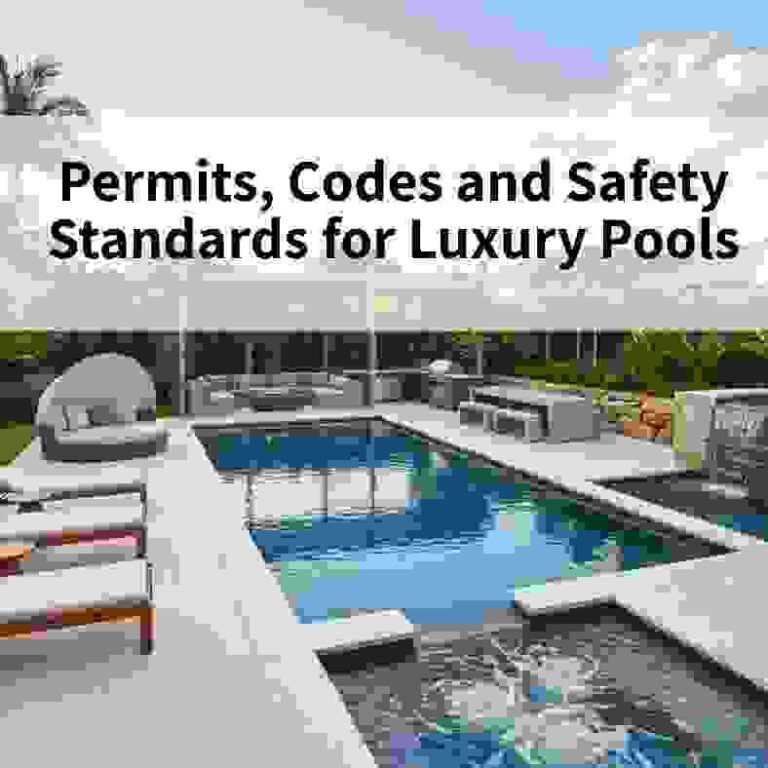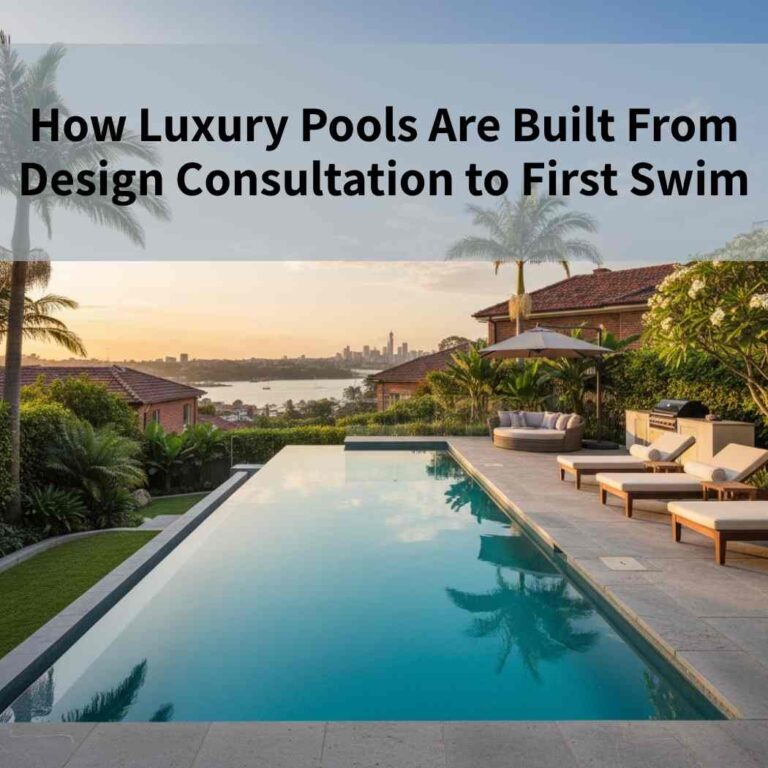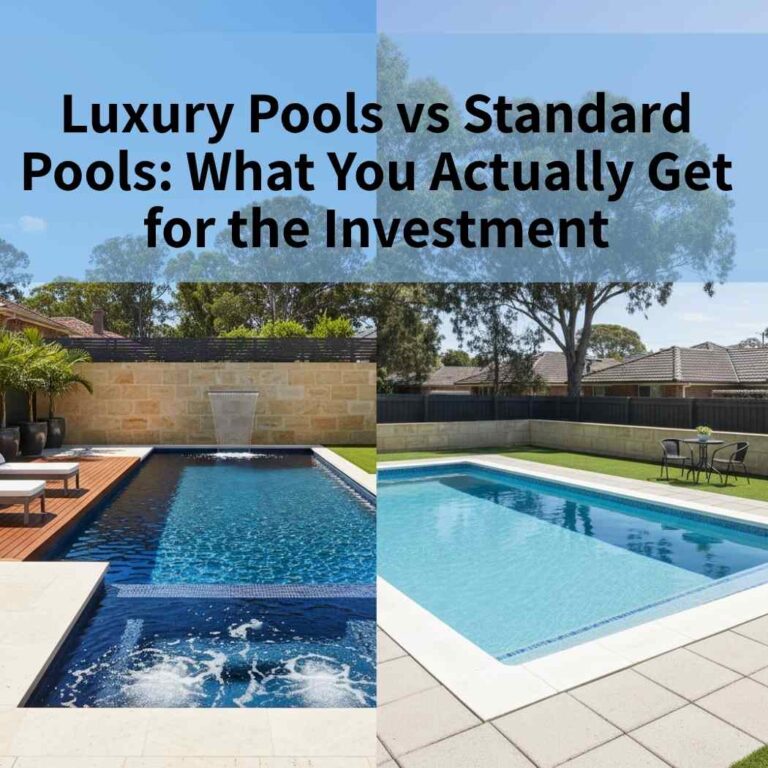At Plunge Pools Sydney, we’ve helped families across Sydney design and build pools for every lifestyle from small plunge pools to large entertainment hubs. Because we know the climate, soil, and council rules, we guide homeowners toward the pool type that lasts and fits their backyard.
In this guide, you’ll see how concrete and fibreglass pools compare for large builds covering design, family features, costs, care, and risks, so you can pick the pool that works best for your home.
Table of Contents
ToggleWhat Families Gain With Each Pool Type
Concrete Pools: Built for Endless Ideas
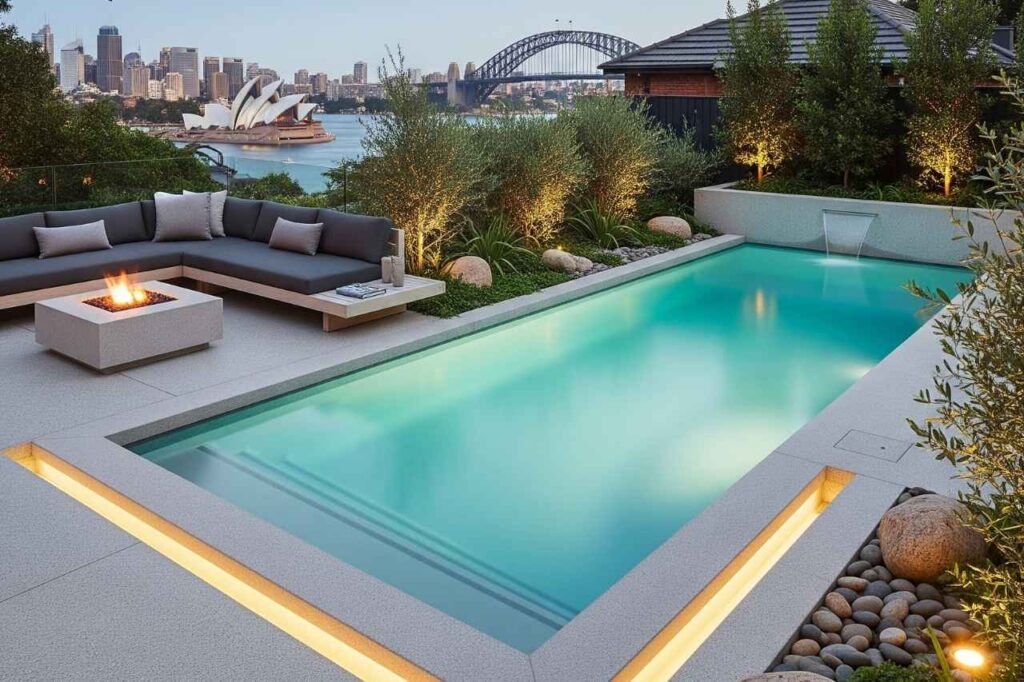
Concrete pools give families the most freedom, you can choose any size, depth, or shape to fit your backyard.
Pros of concrete pools for large builds:
- Custom design: shaped on-site using rebar (steel) and sprayed shotcrete (concrete).
- Endless features: add diving boards, slides, spa zones, or tanning ledges.
- Size flexibility: no limit — ideal for large or unusual yards.
- Long lifespan: 40–50 years with proper care and resurfacing every 10–15 years.
Because concrete pools are built on-site, they adapt to backyards that might not suit a prefabricated shell. Families with bigger blocks can design entertainment hubs with curved edges, beach entries, or infinity edges. If you want your pool to be the heart of family fun with diving zones for teenagers, splash pads for little kids, and a spa for parents, concrete is the most flexible choice.
The trade-off is time and care. A concrete pool can take three to six months to finish, and it needs more cleaning and long-term maintenance compared to fibreglass. But if your vision is a large, one-of-a-kind pool built to last decades, concrete delivers.
Fibreglass Pools: Quick and Family-Friendly
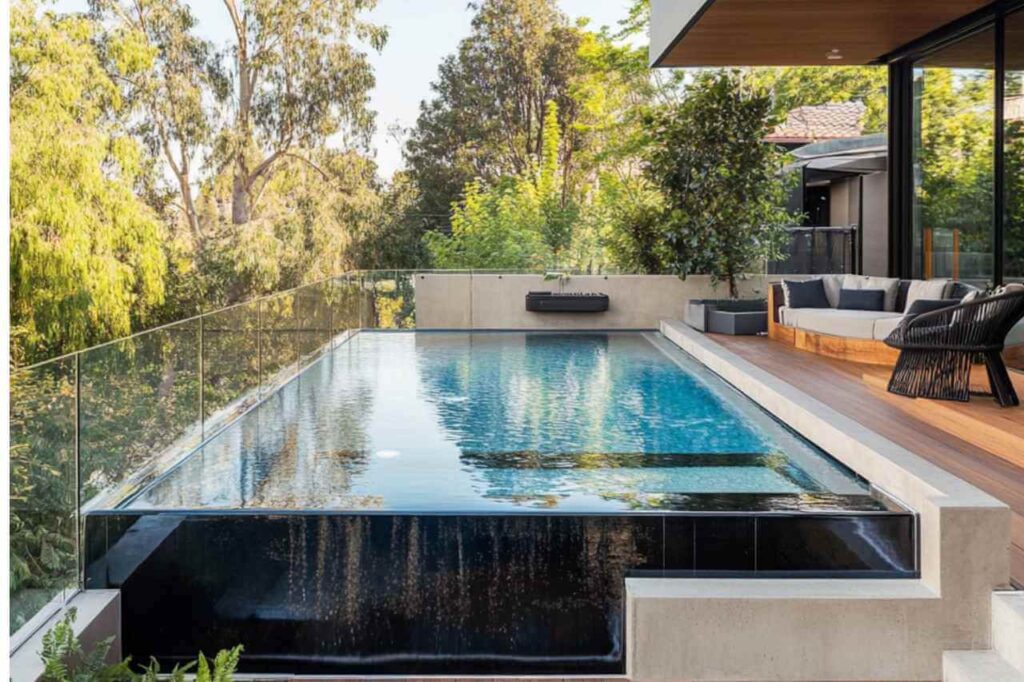
Fibreglass pools are pre-made shells that install fast, feel smooth underfoot, and need less cleaning perfect for busy families.
Pros of fibreglass pools for large builds:
- Fast install: ready in weeks, not months.
- Smooth gelcoat surface: gentle on kids’ skin and toes.
- Low maintenance: resists algae and uses fewer chemicals.
- Budget-friendly: lower upfront and long-term costs.
- Safe for families: even depths and slip-resistant steps.
Fibreglass pools are built in a factory as a single shell, reinforced with resin, then delivered by truck and lowered into place with a crane. This process means installation is quick and less disruptive, families can be swimming in as little as 2–4 weeks, compared to months for concrete.
The gelcoat surface is naturally non-porous, which helps keep water clear and reduces the need for brushing or resurfacing. Most fibreglass pools last 25–30 years with good care, and their smooth finish makes them a safer choice for younger kids.
The main limit is size and shape. Because shells must be transported by road, they usually max out around 12 metres long and 4.5 metres wide. If your vision is a very large, custom-shaped pool, fibreglass may not suit. But for families who want a safe, quick, and low-maintenance pool, fibreglass is a reliable choice.
Concrete vs Fibreglass for Large Builds
Concrete pools are best for very large, custom family builds. Fibreglass pools work well for medium-to-large yards where speed, budget, and low maintenance matter.
Quick Comparison: Concrete vs Fibreglass
| Feature | Concrete Pools | Fibreglass Pools |
|---|---|---|
| Design Flexibility | Unlimited shapes, sizes, infinity edges, beach entries | Fixed moulds, usually up to 12 m long |
| Entertainment Features | Add slides, spas, tanning ledges, swim-up bars | Built-in ledges and steps only |
| Size Limits | No limit, perfect for large blocks | Capped by transport and crane size |
| Installation Time | 3–6 months | 2–4 weeks |
| Lifespan | 40–50 years with resurfacing | 25–30 years with gelcoat |
| Upfront Cost (Sydney) | $80,000–$150,000+ | $60,000–$120,000+ |
| Ongoing Care | More chemicals + resurfacing every 10–15 years | Lower chemical use, easier cleaning |
Note: Final costs depend on site access, excavation, council approvals, and extras like heating, coping, and landscaping.
For large builds, the main difference comes down to customisation versus convenience. Concrete pools give you total freedom to design the pool around your backyard and lifestyle, whether that means a deep end for diving, a swim-up bar for parties, or a curved infinity edge. There’s no size limit, so concrete works best if you have a big block and want a true “family hub.”
Fibreglass pools, on the other hand, are limited to mould sizes. Most top out at around 12 metres, which is big enough for many families but not for Olympic-style designs. The trade-off is speed: a fibreglass pool can be installed in weeks, with less disruption to your yard, and ongoing care is easier thanks to the smooth gelcoat shell.
In short: concrete pools win on creativity and scale, while fibreglass pools win on speed and simplicity.
Entertainment Feature Showdown: Concrete vs Fibreglass
Concrete pools are better for slides, spas, and party zones. Fibreglass pools include family-friendly steps and tanning ledges, but offer fewer custom add-ons.
Head-to-Head Comparison
- Slides & Play Zones
- Concrete: Can be shaped with splash pads, curved slides, and shallow play areas for kids.
- Fibreglass: Some modern shells now feature integrated shallow ledges and wide steps, but adding custom slides is harder.
- Built-In Spas & Tanning Ledges
- Concrete: Easy to integrate spa zones, swim-up bars, or tanning ledges during construction.
- Fibreglass: Many shells come with family-friendly tanning ledges and bench seating, but options are fixed by mould.
- Outdoor Kitchens & Party Hubs
- Concrete: Can be designed to flow with outdoor kitchens, fire pits, and landscaped zones — a true backyard hub.
- Fibreglass: Works as a standalone pool; outdoor furniture and decking can be added after, but less integrated with the shell.
- Multi-Generational Use
- Concrete: Custom depth zones let toddlers, teens, and adults all enjoy the same pool.
- Fibreglass: Safer for young kids thanks to smooth gelcoat and even depths, but lacks deep ends for diving.
For families who see the pool as their main entertainment space, concrete is the more flexible option. You can build a resort-style hub with splash zones for kids, tanning ledges for parents, and a swim-up bar for guests. These features are integrated at construction, making the pool the centrepiece of backyard parties and gatherings.
Fibreglass pools, while more limited in design, have come a long way. Many shells now feature integrated bench seating, shallow play areas, and wide entry steps, making them comfortable for families with young children. They’re safer for little ones and simpler to maintain, which is why many busy households prefer them.
In short: choose concrete if you want a backyard entertainment hub, or fibreglass if you want safe, ready-made family features.
Cost Breakdown: Upfront vs Long-Term
In Sydney, large concrete pools usually cost between $80,000 and $150,000+ installed. Fibreglass pools are more affordable, ranging from $60,000 to $120,000+. Concrete costs more to build and maintain, while fibreglass is cheaper to install and easier to look after.
Sydney Pool Cost Comparison
| Cost Factor | Concrete Pools | Fibreglass Pools |
|---|---|---|
| Upfront Install Cost | $80,000–$150,000+ | $60,000–$120,000+ |
| Installation Time | 3–6 months | 2–4 weeks |
| Maintenance | Higher chemical use | Lower chemical use |
| Resurfacing / Repairs | Needs resurfacing every 10–15 years ($10k–$20k) | Minor gelcoat repairs only if needed |
| Average Lifespan | 40–50 years with resurfacing | 25–30 years |
The biggest difference between concrete and fibreglass pools is how costs play out over time.
- Concrete pools: They cost more upfront because they’re built on-site with steel (rebar) and sprayed shotcrete. You also need to budget for resurfacing every 10–15 years, which can add another $10,000–$20,000 over the pool’s life. On the plus side, a well-built concrete pool can last 40–50 years, and it may increase your property’s value thanks to its fully custom design.
- Fibreglass pools: These come as pre-moulded shells made in a factory, so installation is faster and labour costs are lower. Ongoing maintenance is cheaper too, the gelcoat surface resists algae, so you use fewer chemicals and spend less time cleaning. A fibreglass pool typically lasts 25–30 years, with only minor gelcoat touch-ups needed if it’s cared for properly.
For families planning a large build in Sydney, it’s smart to look beyond the upfront price and consider total costs across decades. Concrete pools demand more money and maintenance but give unmatched design freedom. Fibreglass pools cost less overall and are easier to run, making them ideal for busy households.
Family + Entertainment Design
Concrete pools suit families who host big BBQs and pool parties, while fibreglass pools fit busy families who want safe, simple swims for kids.
How Each Pool Type Fits Family Life
- Concrete Pools for Party Hosts
Concrete works best if your backyard is the entertainment hub. You can design wide steps, tanning ledges, and even outdoor kitchens and fire pits around the pool. Deeper zones make it fun for teenagers and adults, while shallow entries can be added for toddlers. If your weekends often mean BBQs, birthdays, or friends over, a concrete pool is easier to shape into a party-ready space. - Fibreglass Pools for Everyday Use
Fibreglass pools shine in homes where families want fast, easy fun with less work. Many shells include shallow ledges and bench seating, making them safer for young children and relaxing for parents. Because they install in weeks and need less cleaning, fibreglass pools are ideal for busy households where time is tight but daily dips are part of the routine.
The choice often comes down to lifestyle rhythm:
- If your family likes hosting all-day gatherings with food, music, and plenty of swimming, a concrete pool is more adaptable. You can build zones that match every age group and connect the pool seamlessly with your outdoor living.
- If your family prefers quicker swims after work or school, with low upkeep and safety for little ones, a fibreglass pool makes more sense. It’s less about building a resort-style hub and more about simple, reliable family time.
In short: concrete = family entertainment hub, fibreglass = safe everyday family dips.
How Each Pool Type Works in Large Builds
Concrete pools are built on-site with steel rebar and sprayed concrete (gunite or shotcrete). Fibreglass pools are pre-moulded shells made in a factory, delivered by truck, and lowered into place with a crane.
Concrete Pools: Built On-Site
- Excavation shapes the pool hole to fit your yard.
- A steel frame (rebar) is placed for strength.
- Sprayed concrete (gunite or shotcrete) forms the pool shell.
- Custom features like beach entries, infinity edges, or tanning ledges are added as the shell sets.
- Once cured, the pool is finished with tiles, plaster, or other surface materials.
Because construction happens on location, concrete pools offer total flexibility in size and design. They can handle sloping blocks, unusual shapes, and very large builds that fibreglass shells cannot match.
Fibreglass Pools: Pre-Moulded Shells
- The pool is made in a factory using fibreglass and resin.
- A smooth gelcoat surface is applied to resist algae and reduce cleaning.
- The shell is transported to your property on a truck.
- A crane lowers it into the excavated hole.
- Plumbing, backfill, and finishing touches are added before it’s swim-ready.
This method means fibreglass pools are quicker to install (often in 2–4 weeks) and more consistent in finish. However, they are limited by transport size (usually up to 12 metres long and about 4.5 metres wide), so they can’t match the scale of custom concrete builds.
For families planning a large pool in Sydney, the build method often decides the choice:
- A concrete pool is like building a custom house extension — slower, more expensive, but designed exactly how you want.
- A fibreglass pool is like installing a pre-built home unit — fast, neat, and cost-effective, but limited to set sizes.
Both options deliver strong, long-lasting pools. The main difference is whether you want creative freedom with concrete or fast, low-hassle installation with fibreglass.
Long-Term Value for Family Fun
Concrete pools last 40–50 years with resurfacing every 10–15 years. Fibreglass pools last 25–30 years with lower yearly costs thanks to their smooth gelcoat surface.
Lifespan & Maintenance Comparison
| Factor | Concrete Pools | Fibreglass Pools |
|---|---|---|
| Average Lifespan | 40–50 years (with resurfacing) | 25–30 years |
| Maintenance Cycle | Needs resurfacing every 10–15 years | Only minor gelcoat repairs if needed |
| Chemical Use | Higher chemical demand due to porous surface | Lower chemical use thanks to non-porous gelcoat |
| Energy & Water | May require more pump time and water top-ups | More energy-efficient and less water loss |
| Yearly Costs | Higher upkeep and cleaning bills | Lower upkeep and chemical costs |
The value of a pool isn’t just in the upfront build, but it’s in how it performs over decades of family use.
- Concrete pools are the long-haul choice. With regular care and resurfacing, they can last half a century. Their porous surface means they need more chemicals and cleaning, and resurfacing every decade or so can cost $10,000–$20,000. Still, their flexibility and longevity can make them a strong investment for families who want a backyard centrepiece for generations.
- Fibreglass pools deliver reliable value through low maintenance and energy efficiency. The gelcoat surface is non-porous, so algae struggles to grow. This means fewer chemicals, shorter pump cycles, and lower power bills each year. They typically last 25–30 years, and only require small gelcoat touch-ups if maintained.
When families look beyond the installation cost, the trade-off is clear:
- Concrete = longer lifespan with higher upkeep.
- Fibreglass = shorter lifespan with lower yearly costs.
In short, if you’re thinking about value across decades, concrete may outlast fibreglass. But if your family values easy, affordable upkeep each year, fibreglass is often the better choice.
Which Is Better for Families Planning Large Builds?
The truth is: there’s no single right answer. It depends on your family’s goals.
Concrete Choose Concrete if…
You want a custom family entertainment hub — with slides, deep ends, spas, and outdoor integration. You’re ready for a longer build and ongoing care.
Fibreglass Choose Fibreglass if…
You want a fast, family-friendly option that’s low-maintenance, smooth for kids, and easier on the budget.
At Plunge Pools Sydney, we often help families map out these choices with real backyard layouts and lifestyle goals in mind. We design for the way your family wants to live, not just the pool itself.
Talk to a project specialist →Conclusion
When it comes to fibreglass vs concrete pools for large builds, the decision comes down to customisation, size, and how your family plans to use the pool for entertainment.
Concrete pools are best if you want a custom, long-lasting entertainment hub. Fibreglass pools are better if you want a fast, safe, and low-maintenance option for everyday family swimming.
Ready to plan your dream pool? Contact Plunge Pools Sydney today and let us design a pool that fits your backyard, budget, and lifestyle.
FAQs
Do I need council approval for a large concrete or fibreglass pool in Sydney?
Yes, most large pools in Sydney require council approval. Approval ensures safety fencing, drainage, and structural rules are met. Your pool builder will usually handle the paperwork, but it’s smart to confirm with your local council before construction starts.
How do concrete and fibreglass pools perform with Sydney’s coastal conditions and saltwater systems?
Both pool types can handle coastal conditions and saltwater systems, but they perform differently. Concrete pools need proper waterproofing and resurfacing over time to resist salt damage. Fibreglass pools have a gelcoat surface that naturally resists corrosion, making them low-maintenance in salty environments.
What is the lifespan of a concrete pool compared to a fibreglass pool?
A well-built concrete pool can last 40–50 years with resurfacing every 10–15 years. Fibreglass pools usually last 25–30 years, with their smooth gelcoat keeping them easy to maintain. The right care and water balance will extend the life of both pool types.
Can I install heating systems in both concrete and fibreglass pools?
Yes, both concrete and fibreglass pools can be fitted with heating systems like solar, gas, or electric heat pumps. Concrete retains heat well due to its structure, while fibreglass warms up faster thanks to its smooth shell. Your builder can match the best heating option to your family’s lifestyle and budget.
Which pool type is safer for kids — concrete or fibreglass?
Fibreglass pools are generally safer for kids because of their smooth, non-abrasive surface. Concrete pools can be customised with shallow play zones and slip-resistant finishes, but they may feel rougher on little feet. Both types need compliant fencing and safety covers to keep families protected.
How does each pool type affect ongoing energy and water costs?
Fibreglass pools are more energy-efficient as their smooth surface reduces pump time and chemical use. Concrete pools may need more water top-ups and electricity for cleaning systems. Choosing energy-efficient pumps and covers can lower costs for both pool types.


